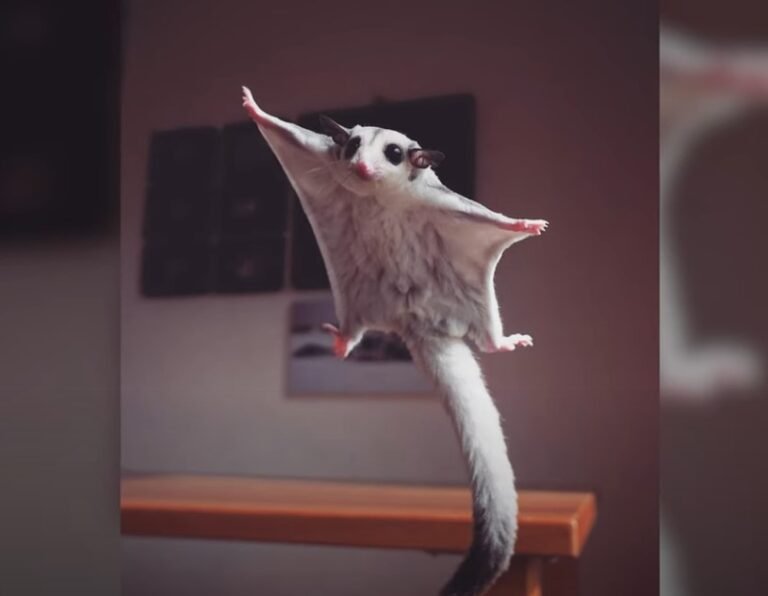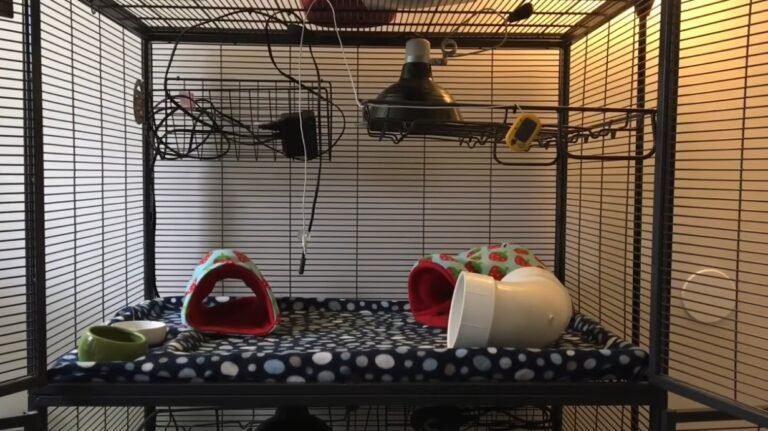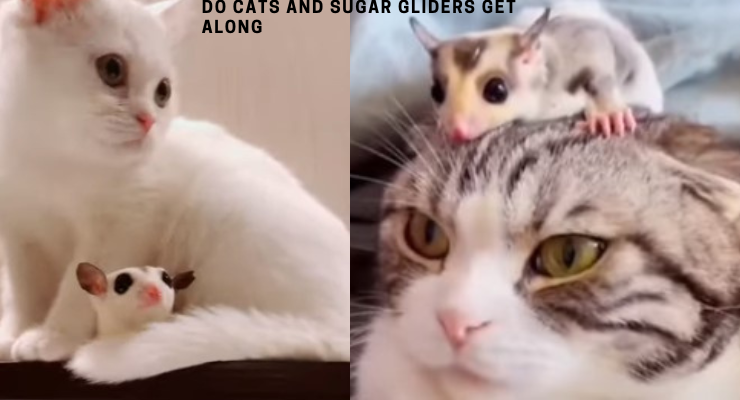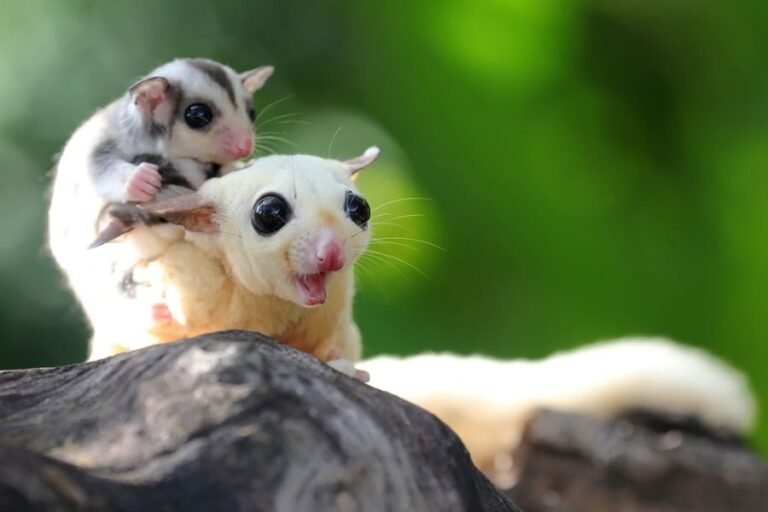How To Tell If A Sugar glider Is Male Or Female
Sugar gliders are fascinating animals that have gained popularity as pets in recent years. One of the challenges that new owners may face is determining the gender of their sugar glider. Knowing whether your pet is male or female is important for proper care and nutrition, as well as avoiding unwanted breeding.
To determine the gender of a sugar glider, examine their genitalia. Male sugar gliders have a bifurcated penis with two prongs, while females have a single genital opening called a cloaca. If unsure, consult with a veterinarian or experienced breeder for assistance.
In this article, we’ll discuss how to tell if a sugar glider is male or female and provide some helpful tips for sexing these adorable creatures.
Methodology of Sugar Gliders
The Best Time To Check For Sugar Glider Gender
The best time to check the gender of a sugar glider is when they are around 8-12 weeks old. At this age, their genitalia will have developed enough to be able to determine whether they are male or female.At this point, the males will have developed testicles and scrotal sacs, while females will have a visible vaginal opening.
It’s important to note that determining the gender of a sugar glider can be difficult and requires experience and expertise. It’s best to consult with a veterinarian or an experienced breeder for assistance.
The Tools You Will Need For Sugar Glider Gender Identification
To identify the gender of a sugar glider, you will need a few tools:
Small flashlight or torch – A small flashlight or torch is necessary to shine light on the genital area and determine the sugar glider’s gender.
Soft cloth or towel – You’ll need a soft cloth or towel to gently handle and hold the sugar glider while you examine them. This will also help prevent any scratches or bites.
Magnifying glass (optional) – A magnifying glass can be helpful for better visibility and getting a closer look at the sugar glider’s genital area.
Experienced Handler – Sugar gliders are delicate animals, so an experienced handler who knows how to handle them safely and without causing them harm is important.
Patience – Finally, patience is key when examining sugar glider genders. It may take some time to determine their gender, especially if they are young or uncooperative. Don’t rush the process or force the sugar glider into any uncomfortable positions.
The Step-By-Step Process Of Identifying Sugar Glider Gender
Here is a step-by-step process for identifying the gender of a sugar glider:
Step1:Gather your tools
You will need a small flashlight or torch, soft cloth or towel, and optional magnifying glass.
Step2:Gently handle the sugar glider
Carefully pick up the sugar glider and hold it on its back with its belly facing upward. Use the soft cloth or towel to support the sugar glider’s body and prevent any scratches or bites.
Step3:Examine the genital area
Use the small flashlight or torch to shine light on the sugar glider’s genital area. In males, you’ll be able to see their scrotal sacs and penis, while in females, you’ll see their vulva.
Step4:Identify the gender
Based on what you see, determine whether the sugar glider is male or female.
Step5:Record your findings
If you’re able to identify the sugar glider’s gender, record your findings so that you can keep track of each individual’s sex.
Step6:Repeat as necessary
If you’re unable to determine the gender during your first attempt, wait a few days and try again. As the sugar glider grows and matures, their genitalia will become more visible.
Step7:Handle the sugar glider with care
It’s important to handle sugar gliders gently and with care during any type of examination or handling, to avoid causing them stress or injury.
Step8:Seek assistance if necessary
If you are unsure or inexperienced, it’s best to consult with a veterinarian or an experienced breeder for assistance.
Identifying sugar glider gender requires patience, gentle handling, and proper tools like a small flashlight or torch and soft cloth or towel.
Identifying Male Sugar Gliders

Physical characteristics of male sugar gliders
Identifying male sugar gliders can be done by looking for a few distinct physical characteristics. Below the physical characteristics of male sugar gliders:
Scrotum and testicles
The male sugar glider has a pair of round testicles that hang outside its body. The scrotum is a sac-like structure that hangs down from the sugar glider’s abdomen. The scrotum covers the testicles and protects them.
Cloacal pouch
The cloacal pouch is a pouch that sits at the end of the sugar glider’s digestive system. It is located between the legs. It looks like a pouch with a hole in the middle.
Distance between anus and genitalia
If you want to know whether the sugar glider is male or female, you will have to look at the distance between the anus and the genitalia. Males usually have this distance longer than females. You will also have to look at the fur pattern around the genitals. Female sugar gliders will have a patch of fur on their hips and buttocks. Male sugar gliders will have a smooth fur pattern on their buttocks and around their anal region.
Penis:
Male sugar gliders have a small penis that protrudes from their cloacal pouch. The penis is also used to deposit sperm.
Pelvic bones
The pelvic bones of the male sugar glider are very pronounced. The bones connect the pelvis to the legs. The pelvis is a large bone that forms the lower portion of the body. The pelvis is located between the thigh and the torso.
Hairs around the eyes
If you look closely at the face of a sugar glider, you will see the characteristic facial hair that is associated with male sugar gliders. There are no female sugar gliders. The hairs are found only on the face. Some males will have the characteristic facial hair.
How to properly handle male sugar gliders during identification
When handling male sugar gliders for identification, it is important to take several precautions to ensure their safety and well-being.
Wear gloves: Male sugar gliders have scent glands on their forehead and chest, so it’s best to wear gloves when handling them to avoid getting the scent on your skin and clothing.
Handle gently: Sugar gliders have fragile limbs that can easily become injured, so make sure to handle them gently and avoid grasping them too tightly.
Observe genitals: To identify a male sugar glider, observe their genitals. Males have a bifurcated penis, which means it splits into two separate shafts at the end. Females, on the other hand, have a single genital opening called a cloaca.
Start young: Sugar gliders are social animals and thrive in pairs or small groups. If possible, start handling male sugar gliders while they are still young and get them used to human interaction. This will make it easier to handle them as they grow older.
Provide a safe environment: Make sure to provide a safe environment for male sugar gliders when handling them. Keep them away from other pets and any potential hazards, such as sharp objects or toxic substances.
By following these guidelines, you can ensure the safety and well-being of male sugar gliders during identification.
Tips on distinguishing juvenile male sugar gliders from adult males
Distinguishing juvenile male sugar gliders from adult males can be challenging since they look very similar. However, there are a few tips that can help you with the identification process:
Size: Adult male sugar gliders are generally larger than juveniles. They can weigh up to 160 grams, while juveniles usually weigh around 10-15 grams.
Behavior: Juvenile males tend to be more active and playful than adult males. They also tend to be more curious and explore their environment more.
Fur: The fur of adult male sugar gliders is usually thicker and coarser than that of juveniles. Juveniles may have finer, softer fur.
Scent glands: Adult male sugar gliders have well-developed scent glands on their forehead and chest, while juveniles may not have fully developed scent glands yet.
Genitalia: Male sugar gliders have a bifurcated penis, which means it splits into two separate shafts at the end. This can be easier to see in adult males, as the genitalia will be fully developed.
These are just a few tips that can help you distinguish between juvenile male sugar gliders and adult males. However, keep in mind that some of these characteristics may overlap and are not always reliable indicators. It’s best to consult with an experienced veterinarian or breeder for a more accurate identification.
Identifying Female Sugar Gliders

Physical characteristics of female sugar gliders
Below the some physical characteristics of female sugar gliders:
Cloaca: Female sugar gliders have a single genital opening called a cloaca, which is located on their underside.
Size: Female sugar gliders are generally smaller than males. They can weigh up to 115 grams, while males can weigh up to 160 grams.
Pouch: Female sugar gliders have a pouch on their abdomen where they carry and nurse their young. This pouch is not present in males.
Vulva: Male sugar gliders have a pair of penile bulbs on their abdomen. These are not present in females. Females have a pair of ovaries in their abdomens and one pair of testes on their ventral side. The testes are surrounded by a sac-like structure called the tunica albuginea. The vagina is located just behind this sac.
Distance between anus and genitalia: The female’s genitalia is quite different. It is shaped like a cup with a small opening at the bottom. The penis is long and extends into the genital pouch. There is a furred structure that extends out of the vagina.
Fur: The fur of female sugar gliders is usually thicker and softer than that of males. It may also be slightly lighter in color.
Scent glands: Female sugar gliders have scent glands on their forehead and chest, similar to males. However, these glands are usually smaller and less developed.
Nipples: Female sugar gliders have nipples on their underside, which are used to nurse their young.
Body shape: Female sugar gliders tend to have a more rounded body shape than males, especially when they are carrying young in their pouch.
Facial features: Some people find that female sugar gliders have a narrower face and muzzle than males, although this can be difficult to discern without close examination.
Behavior: Female sugar gliders may exhibit different behavior than males, especially during mating season. They may be more territorial or aggressive, for example.
Voice: Female sugar gliders may have a higher-pitched voice than males, which can be another way to identify them apart.
These are some of the most common physical identification characteristics of female sugar gliders. Keep in mind that there may be individual variations and it’s always best to consult with an experienced veterinarian or breeder for an accurate identification.
How to properly handle female sugar gliders during identification
Here are some steps to properly handle female sugar gliders during identification:
Prepare the necessary equipment: Before attempting to handle your sugar glider, make sure you have all the necessary equipment on hand. This includes a bonding pouch, gloves, and a towel.
Approach your sugar glider calmly: Sugar gliders are sensitive creatures and can become anxious or scared if approached too quickly or aggressively. Approach your sugar glider slowly and calmly to avoid causing unnecessary stress.
Use gloves: Female sugar gliders can be territorial and may bite if they feel threatened. To protect yourself from potential bites and scratches, it is best to wear gloves when handling your sugar glider.
Place your sugar glider in a bonding pouch: A bonding pouch provides a safe and secure space for your sugar glider while you handle her. Gently place your sugar glider in the pouch and allow her time to settle in before attempting to identify her.
Check for identifying features: To identify a female sugar glider, check for identifying features such as a bald patch on the stomach (indicating recent breeding), a visible pouch, or a smaller size compared to male sugar gliders.
Keep handling sessions short: Sugar gliders are social animals and enjoy spending time with their owners. However, it is important to keep handling sessions short to avoid causing stress or discomfort to your sugar glider.
Reward your sugar glider: After each handling session, reward your sugar glider with a treat or a small amount of food. This will help reinforce positive behavior and strengthen the bond between you and your sugar glider.
By following these tips, you should be able to properly handle and identify your female sugar glider without causing any unnecessary stress or harm to your pet.
Tips on distinguishing juvenile female sugar gliders from adult females
Here are some tips on how to distinguish juvenile female sugar gliders from adult females:
Look at their size and weight: Juvenile female sugar gliders are typically smaller than adult females and weigh less as well.
Observe their behavior: Juvenile female sugar gliders tend to be more active, curious, and playful than adult females. They may also be more willing to explore their surroundings and interact with their owners.
Check for physical characteristics: Adult females generally have a visible pouch on their stomachs, which is used for carrying their young. Juvenile females will not yet have this feature. Additionally, adult females may have a bald spot on their stomachs from recent breeding activity.
Consider their age: Sugar gliders are considered adults after reaching sexual maturity, which is typically around 8-12 months of age. If you know the age of your sugar glider or have an estimate, this can help determine whether she is a juvenile or adult female.
Consult with a veterinarian: If you’re unsure about the age or sex of your sugar glider, it may be helpful to consult with a veterinarian who has experience working with these animals. They can perform a physical exam and provide more information on how to properly care for your sugar glider.
By considering these tips, you should be able to distinguish between juvenile and adult female sugar gliders with greater ease.
Factors That Can Affect Gender Identification
Gender identification is a complex process that can be influenced by multiple factors, including:
Biological factors:
Biological factors such as sex chromosomes, hormones, and brain structure can play a role in gender identity.
Socialization
The way in which an individual is socialized can affect their gender identity. This includes the ways in which they are raised, the messages they receive about gender roles and expectations, and the cultural norms surrounding gender.
Cultural and societal norms
Cultural and societal norms vary across different communities and can influence an individual’s gender identity. For example, some cultures have more rigid gender roles than others.
Sexual orientation
An individual’s sexual orientation may also play a role in their gender identity. For example, some individuals who identify as transgender may also identify as gay, lesbian, or bisexual.
Personal experiences
Personal experiences, such as trauma or discrimination, can impact an individual’s gender identity.
Mental health
Mental health conditions such as gender dysphoria can affect an individual’s gender identity.
It’s worth noting that gender identity is a complex and individual experience, and there is no one-size-fits-all explanation for why someone identifies with a particular gender.
Why Gender Matters
The gender of a sugar glider can matter for a few different reasons. One reason is that male and female sugar gliders may have slightly different temperaments and behaviors, which can affect their suitability as pets or breeding animals.
Male sugar gliders are generally more territorial than females, and may be more likely to mark their territory with urine or engage in aggressive behavior towards other gliders. Females are typically more social and may be more inclined to form close bonds with their owners or other gliders.
Additionally, if you are interested in breeding sugar gliders, it is important to understand the gender of your animals, as males and females will need to be housed separately unless you are intentionally breeding them. Breeding sugar gliders requires careful planning, as females can become pregnant as early as four months old and may produce several offspring at once.
Overall, while both male and female sugar gliders can make wonderful pets, understanding the differences between the genders can help you choose the right animal for your needs and ensure that you are able to provide appropriate care and housing.
Common Misconceptions About Sugar Gliders
There are several common misconceptions about sugar gliders, including:
Sugar gliders are low-maintenance pets
While sugar gliders can be wonderful pets, they require a lot of care and attention. They need a specialized diet, plenty of exercise, and regular grooming. They also require a large cage and lots of socialization with their owners or other gliders to remain healthy and happy.
Sugar gliders are nocturnal animals
While sugar gliders are most active at night, they are not strictly nocturnal. They may be active during the day as well, especially if they are well-rested and have plenty of stimulation.
Sugar gliders can live alone
Sugar gliders are social animals and thrive in groups. Keeping a single sugar glider as a pet can lead to loneliness and behavioral problems, such as self-mutilation or aggression.
Sugar gliders are easy to breed
Breeding sugar gliders requires careful planning and expertise. It is important to ensure that both the male and female gliders are healthy and genetically diverse, and that the mother receives proper nutrition and care during pregnancy and lactation.
Sugar gliders are rodents
Sugar gliders are actually marsupials, which means that they carry their young in a pouch like kangaroos and koalas. While they share some physical traits with rodents, such as sharp teeth and claws, they are not closely related to rats, mice, or hamsters.
Sugar gliders change gender
Sugar gliders actually don’t change sex. Some people think that sugar gliders can change gender because some are born with two testicles and others have only one testicle.
By understanding these misconceptions and educating yourself about the proper care and needs of sugar gliders, you can provide a happy and healthy home for your pet.
Tips for Raising Male and Female Sugar Gliders
Here are some tips for raising male and female sugar gliders:
Provide a spacious cage
Sugar gliders are active animals and require enough space to jump, climb and glide. The minimum recommended size for a pair of sugar gliders is 24 inches wide, 24 inches deep, and 36 inches tall.
Feed them a balanced diet
Sugar gliders have a very specific dietary requirement and their diet should consist of fresh fruits, vegetables, and protein sources such as insects, eggs, and chicken. You can also provide them with commercially prepared food that meets their nutritional needs.
Bonding and socialization
Sugar gliders are social animals and need companionship. It is recommended to keep them in pairs or groups, but opposite-sex pairs should be neutered to prevent breeding. It’s important to spend time bonding with your sugar gliders every day to establish trust and strengthen your relationship.
Provide opportunities for exercise
Sugar gliders need regular exercise to stay healthy and happy. You can provide them with toys, climbing structures, and wheels in their cage to encourage physical activity. Also, consider creating a play area outside the cage where they can explore and play.
Regular veterinary checkups
Sugar gliders require regular check-ups by a veterinarian experienced in treating exotic pets. These checkups are vital to detect any health issues early and start treatment before it becomes serious.
Remember that sugar gliders are unique pets, and they require special care and attention. With proper care and attention, male and female sugar gliders can make wonderful pets that will bring joy to your life for years to come.
The Ethics of Sugar Glider Gender Identification
The ethics of sugar glider gender identification relate to the methods used to determine the sex of a sugar glider. Some people believe that determining the sex of a sugar glider is an invasive procedure that can cause discomfort or stress to the animal, and may be unnecessary if the sugar glider is being kept as a pet.
There are mainly two methods for determining the gender of a sugar glider: visual inspection and DNA testing. Visual inspection involves examining the genitalia of the sugar glider, while DNA testing involves analyzing the animal’s DNA using laboratory techniques. Both methods have their own advantages and disadvantages.
Visual inspection is a non-invasive method that can be performed by experienced breeders or veterinarians. However, it may cause discomfort or stress to the animal, and there is a risk of injury or infection if the procedure is not done properly. On the other hand, DNA testing is a more accurate and reliable method that does not involve any physical contact with the animal. However, it can be expensive and may require specialized equipment.
In terms of ethics, it is important to consider the welfare of the sugar glider when determining its gender. The procedure should be performed in a gentle, humane way that minimizes any potential harm or distress to the animal. Additionally, it is important to weigh the benefits of gender identification against the risks and costs involved.
Conclusion
In conclusion, sexing a sugar glider is an important aspect of their care and should be done accurately. While it may seem daunting at first, with a little practice, it can be easily accomplished by examining the sugar glider’s genitalia. However, if you’re unsure or uncomfortable doing this, don’t hesitate to seek assistance from a veterinarian or experienced breeder.
It’s also important to remember that sugar gliders are unique creatures with individual personalities and needs, regardless of their sex. By providing them with proper care, love, and attention, you can ensure they live happy and healthy lives as cherished members of your family.
FAQs
1.How do you tell the gender of a sugar glider?
Determining the gender of a sugar glider is important for proper care and breeding. To tell the difference, you can examine their genitalia or look at the distance between their anus and genitalia. If unsure, consult with a veterinarian or experienced breeder.
2.Do all male sugar gliders have a bald spot?
No, not all male sugar gliders have a bald spot. Some male sugar gliders may develop a scent gland on their forehead, but this isn’t always the case. The most accurate way to determine gender is by examining their genitalia or seeking assistance from a professional.
3.What is the pouch on a female sugar glider?
The pouch on a female sugar glider is a unique feature that allows them to carry and nurse their young. Located on their belly, the pouch is where newborn sugar gliders stay for several months until they are mature enough to venture out on their own.
4.How do you tell if Joey is a boy or a girl?
To determine if a Joey is a boy or girl, you can examine their genitalia. Female Joeys have a single genital opening called a cloaca, while male Joeys have a bifurcated penis with two prongs. If unsure, seek assistance from a veterinarian or experienced breeder.
5.What is the best way to handle sugar gliders during gender identification?
The best way to handle sugar gliders during gender identification is to do so gently and with care. It’s important to be patient and allow the sugar glider to feel comfortable with you before attempting to examine them. Seek assistance from a professional if needed.







